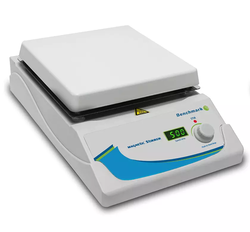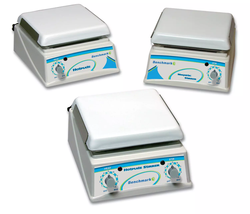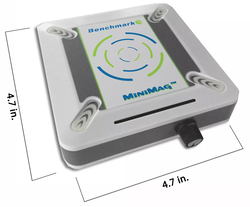Hotplate Stirrers
Every lab needs hotplates and stirrers. Popular among our customers is the classic Accuplate line, from Labnet. These 7 x 7” workhorses heat to 380°C, and come with useful features like an overheat light and provision for an add-on support rod.
Benchmark Scientific have a digital line as well, with small footprint and advanced microprocessor controls. Read temperature and speed with the advanced display system, and add an optional probe for even more precise control. If space is a consideration, have a look at Benchmark’s ‘MiniMag’, a novel 3.4” compact stirrer that accepts an enormous variety of containers, with volumes as large as 1.5 liters. Stirring speed is continuous from 100 to 1500 rpm, and for temperature-sensitive samples, the MiniMag is incubator- and coldroom-safe!
3 product(s) found
Hotplate Stirrers Questions & Answers
What are the types of hotplate stirrers?
A hotplate stirrer is typically used in laboratories to mix fluids. For such purposes, there are two main types of hotplate stirrers. These are the magnetic stirrer and the overhead stirrer. A magnetic stirrer generates a magnetic field. This is what rotates the stir bar which stirs the fluids in the container. On the other hand, the overhead stirrer functions more like a food mixer. This is because it's dropped into the container of the liquid to serve as an agitator.
How fast to hotplate stirrers heat up?
This would usually depend on the material of the hotplate. But generally, such equipment would heat up in a matter of minutes.
What's the maximum volume you can use on a 1,000 hotplate stirrer?
This would depend on the type of sample and the container it's in. Though, for a fluid in a beaker, the maximum volume would be 10-15 liters. This would still allow for stability. This maximum volume is suitable for solutions which are more viscous. Also, it would depend on the vessel you use to stir the liquid.
Is the whole area of the hotplate stirrer heated?
Most hotplate stirrers have hot zones in their middle area. They're also designed to be a lot cooler around the outer area for safety reasons. This design helps reduce the likelihood of getting burned. It would keep you safe even if you accidentally touch the surface of the hotplate.
What's the benefit of a ceramic top hotplate stirrer over an aluminum top one?
One benefit of a stirrer with a ceramic top is that it has excellent temperature and chemical resistance. This means that they can reach temperatures as high as 450°C. Aside from this, they also heat up a lot quicker than aluminum top hotplate stirrers. The surface of ceramic tops is also easier to clean. Finally, they allow for excellent visibility in terms of color changes too.


